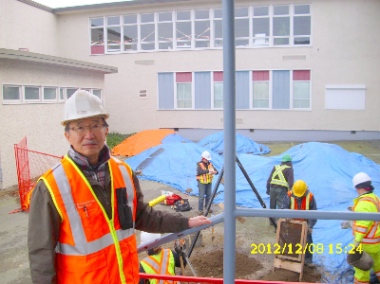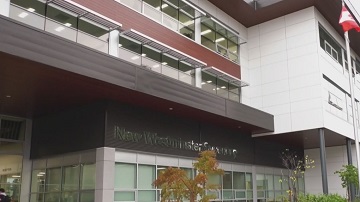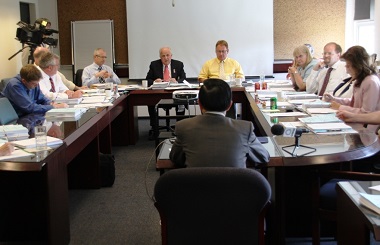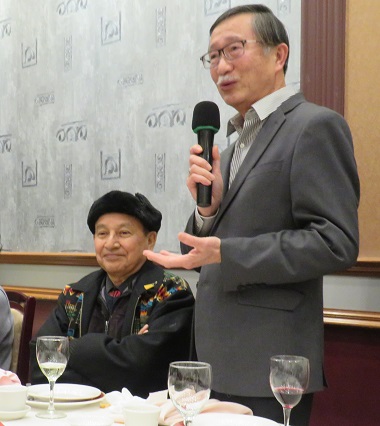
Bill Chu, monitoring the sieving of materials from a minor excavation at the New Westminster Secondary School site in December 2012.
Bill Chu was invited to the official opening of the newly built New Westminster Secondary School October 14. That might seem unusual, because the Christian activist is a retired engineer who lives in Richmond.
But Chu was a key player in the decision to place the school where it is now – and his actions to protect an old burial site now seem prescient, in light of the remains found at the Kamloops Indian Residential School and elsewhere.
A CTV News report stated:
One of the largest high schools in B.C. is now exchanging a problematic past for a new beginning.
The new New Westminster Secondary School officially marked its opening on Thursday with speeches and a ribbon cutting ceremony, after first welcoming students earlier this year.
Meanwhile work is also underway to address the future of the land the previous school was built on, which is a former burial site.
Part of the history of the old high school from 1949, which sits along 8th Street between 10th Avenue and 8th Avenue, includes a darker chapter in time.
Bill Chu with the Canadians for Reconciliation Society [CFRS] said the building was constructed on top of land once used for burials by groups that faced discrimination and segregation, including the Chinese community.
“Normally, a school opening is no news. But this one happens to be unique . . . it’s relocated from one site to another, for good reason” he said. “The previous school to this one, was built on top of Douglas Cemetery, which buried people of colour and marginalized (people), Indigenous people.”

New Westminster Secondary School was officially opened October 14.
Here is how Chu began an email he sent out to supporters October 17:
This all started in 2008 with the reconstruction plan of the old New Westminster Secondary School which was built in 1948 right over an un-decommissioned cemetery for the marginalized and people of color (two-thirds of the 33 identified stake holder groups being Indigenous communities).
As its initial sacrilegious construction was a huge mistake1, we at CFRS viewed repeating such over the same former cemetery in the 21st century unacceptable.
After further research into the city’s past history and policies towards the Chinese, CFRS in June 2009 presented the truth we unearthed and invited the City to a process of reconciliation. The City accepted and started a unique process which culminated in the City becoming the first Canadian city to offer a formal apology plus nine other redemptive actions to the Chinese community in 2010.

in 2009, Bill Chu presented the Mayor and Council of New Westminster with the history of the site and an invitation to a process of reconciliation.
As the City’s above offer did not resolve the matter of where to reconstruct the old school, CFRS continued to alert the community, lobby the authorities and the BC government while attempting to update the 22 Indigenous stakeholder groups of the situation.
The latter task turned out to be difficult as many Indigenous communities are far away, often lack resources and manpower and have more pressing matters to respond to.
After defending four heritage sites in BC, I realized BC, during its rapid development, has not been paying due attention to the protection of underground artifacts or archaeological resources.
So as a Professional Engineer, I made a formal motion at the 2012 AGM of the Association of Professional Engineers and Geoscientists of BC to include archaeological consideration in any earth moving activities in engineered projects. It did not pass.
I tried again in 2013 and the motion was thankfully passed. The resulting changes sparked a major revision in the Professional Practice Guideline for Geoscientists in BC. As that involved another professional body, committee meetings, multiple drafts and revisions, legal reviews, etc., the revised Professional Practice Guidelines was not completed until September 2020.
Now that it is in use by all BC Geoscientists, potential construction sites with archaeological significance – like the former NWSS site – will have an established process for archaeological assessment in the future.
Perhaps motivated also by the national call for reconciliation, the city and School District 40 realized the need to relocate the new NWSS and agreed quietly between them to a land swap. That enabled the new NWSS to be completed this January on an adjacent site to the east of the former cemetery.
As for the old cemetery site, the ownership of its smaller southern section where the Massey Theater is was transferred to the city. Currently plans are underway to turn the northern balance of the cemetery into a passive Memorial Park once the above ground structure of the old school is demolished.

When Bill Chu ‘retired’ from 30 years of activism, Grand Chief Stewart Phillip was on hand to praise his work and wish him well.
Chu wrote about his opposition to building on the old site of the school in a Church for Vancouver post in 2016.
He has been very active for many years on issues related to Indigenous people and the Chinese community. Grand Chief Stewart Phillip attended an event which celebrated Chu’s retirement / 70th birthday party in 2018.
Chu’s email concluded:
A moving moment at the official opening occurred not during the speeches but in noting Councillor Lulua from Tsilhqot’in National Government driving 10 hours each way to attend the official opening.
The Indigenous friend’s resolve to seek to honour their forefathers at the former cemetery should inspire us to work harder towards delivering a sincere long-overdue reconciliation.
Towards that end, you can urge the city <[email protected]> and/or School District 40 (SD40) <[email protected]> to:
-
- City/SD40 to release the name list of those interred in the former cemetery so Canadians do not have to face another case of ‘Undocumented remains at a former school site.’
- City to apply to BC government to redesignate the southern section of the former cemetery site as ‘cemetery’ (only the northern mainly ‘White’ section was secretly upgraded to such level of protection by the School District in 2009).
- City and School District to confirm that a restrictive covenant is in place to protect the entire cemetery from other future uses.
- SD40 to update the list of stakeholder groups’ contact info and ensure that all groups’ correct representatives will be informed of future progress and be invited to future planning meetings for the memorial park.
- SD40 to place a plaque in the new NWSS to highlight the history and reason for its relocation and to encourage future generations to continue efforts towards reconciliation.
- SD40 to cause the site’s candid history to be taught in classes.
In closing, I need to thank you for your support and prayers for the movement to reconciliation over all these years. As we have merely started the ball rolling, please continue the effort and share with me any thoughts on the journey.
1, From “Old Bones under Sites of School” on page 1 of the February 11, 1948 issue of British Columbians:
Ancient Human bones on the Eighth Avenue high school site are causing the city engineer department some concern. The abandoned cemetery is part of the area which has to be levelled off by the bulldozers. . . . What to do with the Chinese bones when they are scooped up by the bulldozers is puzzling the engineers. . . . They did not have gravestones. How many coffins and skeletons are hidden under the ground in the area is not known. It is possible the works crews may have to sift the place by hand to retrieve the bones and bury them again at the Fraser Cemetery.

Congratulations, Bill, and well-done!